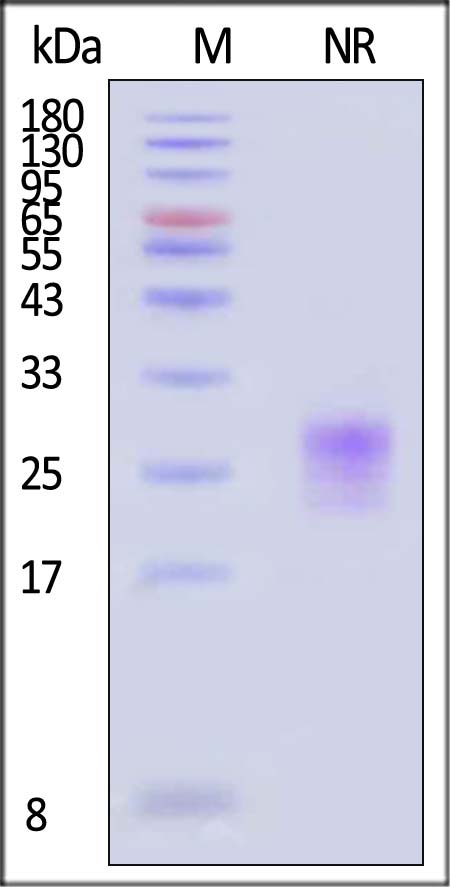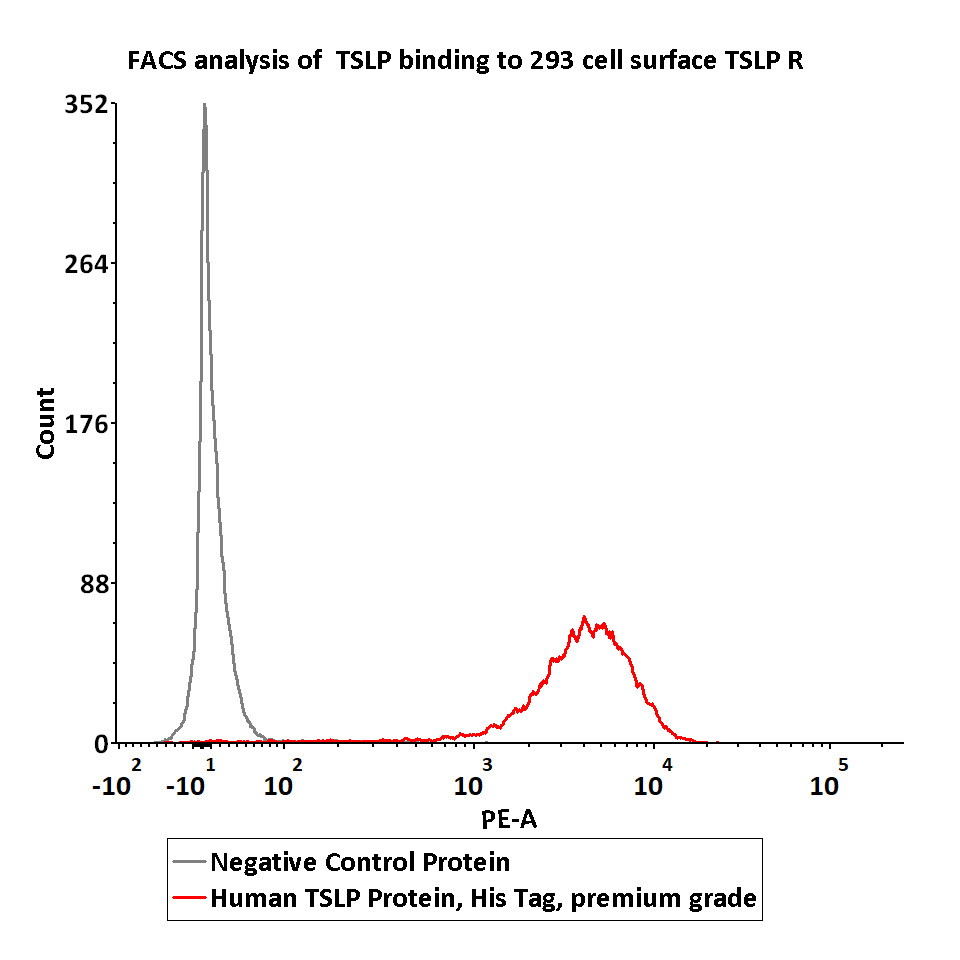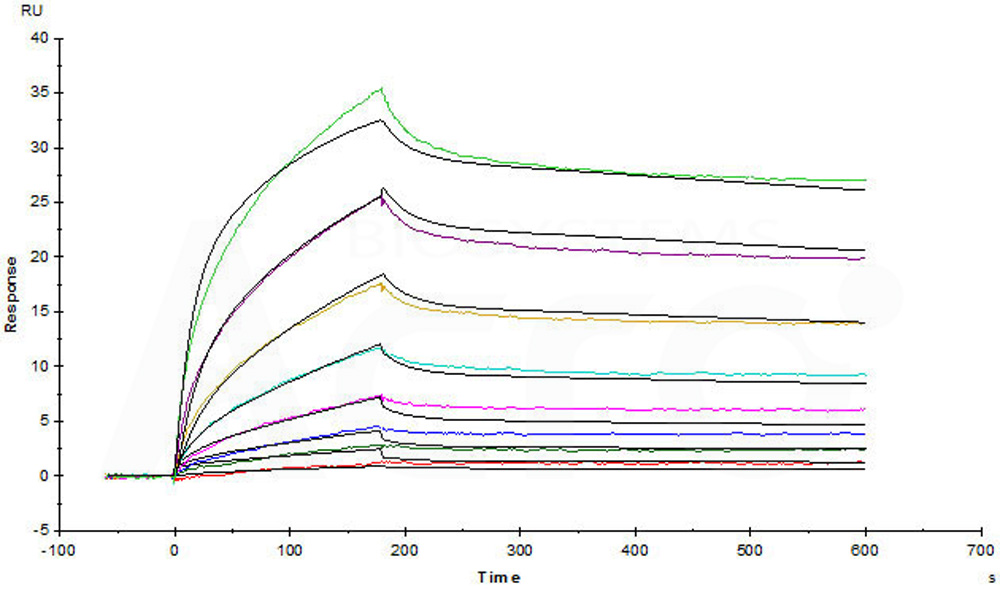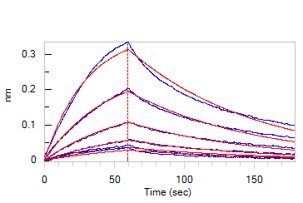分子别名(Synonym)
TSLP
表达区间及表达系统(Source)
Human TSLP Protein, His Tag, premium grade (TSP-H52Hb) is expressed from human 293 cells (HEK293). It contains AA Tyr 29 - Gln 159 (Accession # Q969D9-1).
Predicted N-terminus: Tyr 29
It is produced under our rigorous quality control system that incorporates a comprehensive set of tests including sterility and endotoxin tests. Product performance is carefully validated and tested for compatibility for cell culture use or any other applications in the early preclinical stage. When ready to transition into later clinical phases, we also offer a custom GMP protein service that tailors to your needs. We will work with you to customize and develop a GMP-grade product in accordance with your requests that also meets the requirements for raw and ancillary materials use in cell manufacturing of cell-based therapies.
Request for sequence
蛋白结构(Molecular Characterization)

This protein carries a polyhistidine tag at the C-terminus.
The protein has a calculated MW of 16.8 kDa. The protein migrates as 20-27 kDa when calibrated against Star Ribbon Pre-stained Protein Marker under non-reducing (NR) condition (SDS-PAGE) due to glycosylation.
内毒素(Endotoxin)
Less than 0.1 EU per μg by the LAL method.
无菌(Sterility)
Negative
支原体(Mycoplasma)
Negative.
纯度(Purity)
>90% as determined by SDS-PAGE.
制剂(Formulation)
Lyophilized from 0.22 μm filtered solution in PBS, pH7.4 with trehalose as protectant.
Contact us for customized product form or formulation.
重构方法(Reconstitution)
Please see Certificate of Analysis for specific instructions.
For best performance, we strongly recommend you to follow the reconstitution protocol provided in the CoA.
存储(Storage)
For long term storage, the product should be stored at lyophilized state at -20°C or lower.
Please avoid repeated freeze-thaw cycles.
This product is stable after storage at:
- -20°C to -70°C for 24 months in lyophilized state;
- -70°C for 24 months under sterile conditions after reconstitution.
质量管理控制体系(QMS)
电泳(SDS-PAGE)

Human TSLP Protein, His Tag, premium grade on SDS-PAGE under non-reducing (NR) condition. The gel was stained with Coomassie Blue. The purity of the protein is greater than 90% (With Star Ribbon Pre-stained Protein Marker).
活性(Bioactivity)-Bioactivity CELL BASE

Response to human TSLP protein (Fold).
The TSLPR (Luc) HEK293 Reporter Cell was stimulated with serial dilutions of Human TSLP Protein, His Tag, premium grade (AcroBiosystems, Cat. No. TSP-H52Hb). The max induction fold was approximately 45.15 (Routinely tested).
Protocol
活性(Bioactivity)-FACS

2e5 of Human TSLP R (Luc) HEK293 Reporter Cells were stained with 100 μL of 1 μg/mL of Human TSLP Protein, His Tag, premium grade (Cat. No. TSP-H52Hb) and negative control protein respectively, washed and then followed by PE anti-His Tag Antibody and analyzed with FACS (Routinely tested).
Protocol
活性(Bioactivity)-ELISA

Immobilized Human TSLP Protein, His Tag, premium grade (Cat. No. TSP-H52Hb) at 0.5 μg/mL (100 μL/well) can bind Monoclonal Anti-Human TSLP Antibody, Human IgG2 with a linear range of 0.2-4 ng/mL (QC tested).
Protocol
活性(Bioactivity)-SPR

Captured Human TSLP Protein, His Tag, premium grade (Cat. No. TSP-H52Hb) on CM5 Chip via anti-His antibody, can bind Human TSLP R, Fc Tag (Cat. No. TSR-H525a) with an affinity constant of 1.81 nM as determined in SPR assay (Biacore T200) (Routinely tested).
Protocol

Monoclonal Anti-Human TSLP Antibody (Human IgG2) captured on CM5 chip via Anti-human IgG Fc antibodies surface can bind Human TSLP Protein, His Tag, premium grade (Cat. No. TSP-H52Hb) with an affinity constant of 5.47 pM as determined in a SPR assay (Biacore T200) (Routinely tested).
Protocol
活性(Bioactivity)-BLI

Loaded Monoclonal Anti-Human TSLP Antibody, Human IgG2 on AHC Biosensor, can bind Human TSLP Protein, His Tag, premium grade (Cat. No. TSP-H52Hb) with an affinity constant of 0.263 nM as determined in BLI assay (ForteBio Octet Red96e) (Routinely tested).
Protocol

Loaded Human TSLP R, Fc Tag (Cat. No. TSR-H525a) on Protein A Biosensor, can bind Human TSLP Protein, His Tag, premium grade (Cat. No. TSP-H52Hb) with an affinity constant of 24.7 nM as determined in BLI assay (ForteBio Octet R8) (Routinely tested).
Protocol
 +添加评论
+添加评论背景(Background)
Thymic stromal lymphopoietin (TSLP) is an epithelial cell-derived cytokine involved in the pathology of inflammatory skin diseases, and is widely expressed by epithelial cells. Human TSLP cD encodes a 159 amino acid (aa) residue precursor protein with a 28 aa signal sequence (4, 5). Human TSLP has been shown to developing nondeletional central tolerance, amplifying epithelium-induced class switching, inducing atopic diseases and maintaining intestinal noninflammatory environment. Among diverse cells responding to Human TSLP, CD11c+ dendritic cells are the most obviously characterized target cells.























































 膜杰作
膜杰作 Star Staining
Star Staining
















